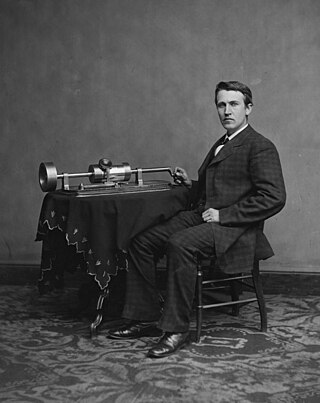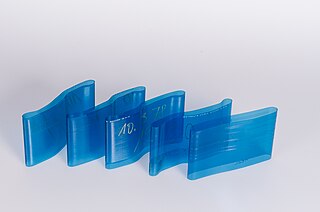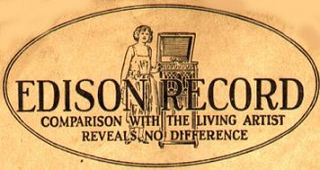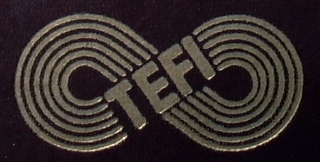
A phonograph, later called a gramophone, and since the 1940s a record player, or more recently a turntable, is a device for the mechanical and analogue reproduction of recorded sound. The sound vibration waveforms are recorded as corresponding physical deviations of a spiral groove engraved, etched, incised, or impressed into the surface of a rotating cylinder or disc, called a "record". To recreate the sound, the surface is similarly rotated while a playback stylus traces the groove and is therefore vibrated by it, very faintly reproducing the recorded sound. In early acoustic phonographs, the stylus vibrated a diaphragm which produced sound waves which were coupled to the open air through a flaring horn, or directly to the listener's ears through stethoscope-type earphones.

An audio tape recorder, also known as a tape deck, tape player or tape machine or simply a tape recorder, is a sound recording and reproduction device that records and plays back sounds usually using magnetic tape for storage. In its present-day form, it records a fluctuating signal by moving the tape across a tape head that polarizes the magnetic domains in the tape in proportion to the audio signal. Tape-recording devices include the reel-to-reel tape deck and the cassette deck, which uses a cassette for storage.

Phonograph cylinders are the earliest commercial medium for recording and reproducing sound. Commonly known simply as "records" in their heyday, these hollow cylindrical objects have an audio recording engraved on the outside surface, which can be reproduced when they are played on a mechanical cylinder phonograph. In the 1910s, the competing disc record system triumphed in the marketplace to become the dominant commercial audio medium.

A phonograph record, a vinyl record, or simply a record or vinyl is an analog sound storage medium in the form of a flat disc with an inscribed, modulated spiral groove. The groove usually starts near the outside edge and ends near the center of the disc. The stored sound information is made audible by playing the record on a phonograph.

The Dictabelt, in early years and much less commonly also called a Memobelt, is an analog audio recording medium commercially introduced by the American Dictaphone company in 1947. Having been intended for recording dictation and other speech for later transcription, it is a write-once-read-many medium consisting of a 5-mil (0.13 mm) thick transparent vinyl plastic belt 3.5 inches (89 mm) wide and 12 inches (300 mm) around. The belt is loaded onto a pair of metal cylinders, put under tension, then rotated like a tank tread. It is inscribed with an audio-signal-modulated helical groove by a stylus which is slowly moved across the rotating belt. Unlike the stylus of a record cutter, the Dictabelt stylus is blunt and in recording mode it simply impresses a groove into the plastic rather than engraving it and throwing off a thread of waste material. The Dictabelt system was popular, and by 1952, made up 90% of Dictaphone's sales.

Mastering, a form of audio post production, is the process of preparing and transferring recorded audio from a source containing the final mix to a data storage device, the source from which all copies will be produced. In recent years, digital masters have become usual, although analog masters—such as audio tapes—are still being used by the manufacturing industry, particularly by a few engineers who specialize in analog mastering.

Videodisc is a general term for a laser- or stylus-readable random-access disc that contains both audio and analog video signals recorded in an analog form. Typically, it is a reference to any such media that predates the mainstream popularity of the DVD format. The first mainstream official Videodisc was the Television Electronic Disc (TED) Videodisc, and the newest is the 4K Ultra HD Blu-Ray Disc. As of September 2023, the active video disc formats are Blu-ray Disc, DVD, and in other regions because of the price difference from DVD, Video CD (VCD) and SVCD.

The Edison Diamond Disc Record is a type of phonograph record marketed by Thomas A. Edison, Inc. on their Edison Record label from 1912 to 1929. They were named Diamond Discs because the matching Edison Disc Phonograph was fitted with a permanent conical diamond stylus for playing them. Diamond Discs were incompatible with lateral-groove disc record players, e.g. the Victor Victrola, the disposable steel needles of which would damage them while extracting hardly any sound. Uniquely, they are just under 1⁄4 in thick.

An acetate disc is a type of phonograph record generally used from the 1930s to the late 1950s for recording and broadcast purposes and sees limited use as of 2009. Despite their name, "acetate" discs do not contain any acetate.

The Capacitance Electronic Disc (CED) is an analog video disc playback system developed by Radio Corporation of America (RCA), in which video and audio could be played back on a TV set using a special stylus and high-density groove system similar to phonograph records.

The overwhelming majority of records manufactured have been of certain sizes, playback speeds, and appearance. However, since the commercial adoption of the gramophone record, a wide variety of records have also been produced that do not fall into these categories, and they have served a variety of purposes.

Sound recording and reproduction is the electrical, mechanical, electronic, or digital inscription and re-creation of sound waves, such as spoken voice, singing, instrumental music, or sound effects. The two main classes of sound recording technology are analog recording and digital recording.
The history of sound recording - which has progressed in waves, driven by the invention and commercial introduction of new technologies — can be roughly divided into four main periods:

The LP is an analog sound storage medium, a phonograph record format characterized by: a speed of 33+1⁄3 rpm; a 12- or 10-inch diameter; use of the "microgroove" groove specification; and a vinyl composition disk. Introduced by Columbia Records in 1948, it was soon adopted as a new standard by the entire US record industry. Apart from a few relatively minor refinements and the important later addition of stereophonic sound in 1957, it remained the standard format for record albums, during a period in popular music known as the album era. Beginning in the late 1970s, LP sales began to decline because of the increasing popularity of Compact Cassettes, then in the 1980s of compact discs. By 1988, the latter format began to outsell LPs.

The conservation and restoration of vinyl discs refers to the preventive measures taken to defend against damage and slow degradation, and to maintain fidelity of singles, 12" singles, EP’s, and LP’s in 45 or 33⅓ rpm 10" disc recordings.

The Gray Audograph was a dictation machine format introduced in 1945. It recorded sound by pressing grooves into soft vinyl discs, like the competing, but incompatible, SoundScriber. It was manufactured by the Gray Manufacturing Company of Hartford, Connecticut, United States.

A dictation machine is a sound recording device most commonly used to record speech for playback or to be typed into print. It includes digital voice recorders and tape recorder.
In the field of audio recording, an aluminum disc is a phonograph record made of bare aluminum, a medium introduced in the late 1920s for making one-off recordings. Although sometimes used for making amateur studio or home recordings or in coin-operated "record-your-voice" booths at fairs and arcades, during the first half of the 1930s bare aluminum discs were primarily used to record radio broadcasts for the private transcription disc archives of performers or sponsors.

The Tefifon is an audio playback format, developed and manufactured in Germany, that utilizes cartridges loaded with an endlessly looped reel of plastic tape. It is somewhat similar to the later 4-track and 8-track magnetic audio tape cartridges, but with grooves embossed on the tape, like a phonograph record. The grooves were embossed in a helical fashion across the width of the tape, in a manner similar to Dictaphone's Dictabelt format. The grooves are read with a stylus and amplified pickup in the player's transport. A Tefifon cartridge, known as a "Tefi", can hold up to four hours of music; therefore, most releases for the format are usually compilations of popular hits or dance music, operas, and operettas. Tefifon players were not sold by television and radio dealers in Germany, but rather sold directly by special sales outlets affiliated with Tefi.

Electrical transcriptions are special phonograph recordings made exclusively for radio broadcasting, which were widely used during the "Golden Age of Radio". They provided material—from station-identification jingles and commercials to full-length programs—for use by local stations, which were affiliates of one of the radio networks.

















